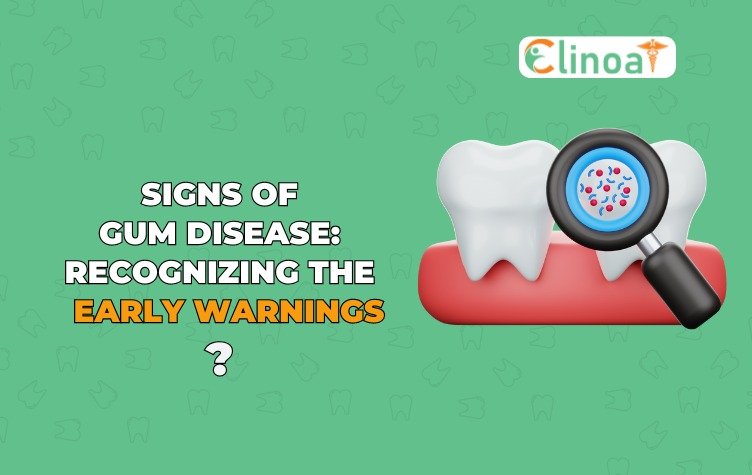Signs of Gum Disease: Recognizing the Early Warnings
Introduction
Gum disease, scientifically referred to as periodontal disease, is a common oral health issue that affects the gums and surrounding tissues. While it can start with mild symptoms, untreated gum disease can lead to serious complications, including tooth loss and systemic health problems. Recognizing the signs of gum disease early is crucial for effective treatment and prevention of further damage. In this article, we’ll explore the various indicators that may signal the presence of gum disease and discuss the importance of proactive dental care.
Understanding Gum Disease
Gum disease encompasses a range of conditions that affect the supporting structures of the teeth, including the gums, ligaments, and bone. It typically begins with the accumulation of plaque, a sticky film of bacteria, on the teeth and along the gum line. If not removed through proper oral hygiene, plaque can harden into tartar, leading to inflammation and infection of the gums.
Several factors contribute to the development of gum disease, including poor oral hygiene, smoking, genetics, hormonal changes, certain medications, and systemic health conditions like diabetes. The condition progresses through stages, starting with gingivitis, characterized by mild inflammation and bleeding gums, and advancing to periodontitis, where the infection spreads deeper into the supporting tissues.
Common Signs and Symptoms
-
Bleeding Gums:
- One of the early signs of gum disease is bleeding gums, especially during or after brushing and flossing. This occurs due to inflammation of the gum tissue, known as gingivitis.
-
Swollen or Red Gums:
- Inflammation and redness of the gums can be indicative of gum disease. Healthy gums should appear pink and firm, so any changes in color or texture may signal an underlying issue.
-
Receding Gums:
- Gums that pull away from the teeth, making the teeth appear longer, can be a sign of gum recession, which is often associated with periodontal issues. Receding gums expose the sensitive root surfaces, increasing the risk of decay and tooth sensitivity.
-
Persistent Bad Breath:
- Chronic bad breath that doesn’t improve with oral hygiene may be a result of bacteria associated with gum disease. These bacteria release foul-smelling compounds, leading to halitosis or persistent bad breath.
-
Tender or Sensitive Gums:
- Gums that are sensitive to touch or pressure may be a sign of underlying gum problems. This sensitivity can make brushing and flossing uncomfortable and may deter individuals from maintaining proper oral hygiene.
-
Changes in Bite or Teeth Alignment:
- Shifting or movement of teeth without an apparent reason can be a sign of advanced gum disease affecting the bone supporting the teeth. As the bone deteriorates, the teeth may become loose or change position, altering the bite alignment.
-
Pus between Teeth and Gums:
- The presence of pus, often seen as a white or yellowish substance, may indicate an infection in the gums. Pus is a sign of active inflammation and should prompt immediate attention from a dental professional.
-
Loose Teeth:
- Advanced gum disease can lead to the loosening of teeth due to damage to the supporting structures. In severe cases, tooth loss may occur if the condition is left untreated.
-
Pain While Chewing:
- Discomfort or pain while eating, particularly when chewing, may be associated with gum disease. This pain can result from infection, inflammation, or damage to the gums and supporting tissues.
Importance of Early Detection
Gum disease can progress silently, often without causing noticeable symptoms in its early stages. However, delaying treatment can lead to irreversible damage to the gums and surrounding structures. Regular dental check-ups are essential for early detection and intervention. Dentists can assess the health of your gums, perform periodontal exams, and provide personalized recommendations for prevention and treatment.
Prevention and Treatment
Preventing gum disease starts with good oral hygiene practices:
- Brushing: Brush your teeth twice a day with fluoride toothpaste, using proper technique and a soft-bristled toothbrush.
- Flossing: Clean between your teeth daily with dental floss or interdental brushes to remove plaque and debris from areas that your toothbrush can’t reach.
- Regular Dental Visits: Schedule routine dental check-ups and cleanings every six months or as recommended by your dentist.
In addition to home care, professional dental cleanings are essential for removing plaque and tartar buildup from the teeth and gums. Depending on the severity of gum disease, treatment options may include scaling and root planning (deep cleaning), antibiotic therapy, surgical procedures, or referral to a periodontics for specialized care.
Conclusion
Gum disease is a common yet preventable condition that can have serious consequences if left untreated. By recognizing the signs and symptoms early and adopting good oral hygiene habits, you can maintain healthy gums and preserve your smile for years to come. Remember to prioritize regular dental check-ups and consult with your dentist if you notice any changes in your oral health.







